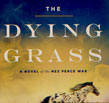 |
 |
 Charles Schneider, D. P. Watt and Cate Gardner
Charles Schneider, D. P. Watt and Cate Gardner
The Transfiguration of Mister Punch
Egaeus Press
UK Hardcover First Edition
ISBN 978-0-957-16063-7
Publication Date: 10-01-2013
258 ages; £30
Date Reviewed: 10-22-2013
Reviewed by: Rick Kleffel © 2013
Horror
Fantasy
General Fiction
Theme anthologies are a staple of genre fiction, but 'The Transfiguration of Mister Punch' is light years beyond such a mundane appellation. The publisher considers it a Triptych, and that seems so much better, more appropriate for this dark wonder of written depravity and art. The entire volume needs to be considered, as Egaeus has gone to some trouble to offer readers a work that seems torn from another reality, one much less friendly to the humans who will enjoy this work.
The intensity of the book at hand glares out at you from the cover, and it never lets go. The endpapers feature disturbing glimpses of Punch freed from puppetry. The book is dosed with creepy little line drawings, and even a few photographs. If your skin is not crawling before you start reading, consider that you may be looking in a mirror and worry.
Mark Beech, the man behind Egaeus, the publisher and unnamed editor of the book, offers a brief introduction; credit him with the sense to keep it short and the artistry to come up with something in the right vein, with the right atmospheric feel. The three novellas that follow live up to Beech's introduction and to the artistry of the book design.
Charles Schneider's "The Show That Must Never Die" starts with a rather unhinged narrator, apparently overcome by his research into the origins of the Punch and Judy figures. But once he gets to the history, it seems legitimate and creepy. Schneider is a writer capable of great subtlety and over-the-top excess in the same breath. The narrative is really quite a tour-de-force as Schneider explores, explodes and eviscerates both the narrative voice and world around the narrator.
Including lots of photos and illustrations in the story serves to bolster both the creep factor and the believability on two levels. On one hand, we believe that the author Schneider is giving us real Punch and Judy history. On the other hand, we believe that the narrator is giving us an authentic glimpse into reality as he sees it. The upshot is s story that is truly unsettling, even for those who read lots of horror fiction and feel themselves perhaps numbed to violence. There's very little gore or violence in "The Show That Must Never Die," but there's an incredible talent for crafting unease that does not go away.
D. P. Watt takes a perhaps more traditional narrative strategy in "Memorabilia." It's a very traditional frame story, with a collector speaking to a client who buying a collection of Punch and Judy items. There are four stories in the single story, each one wonderful in itself, the sum of them rather more so. In "With Gravity, Grace," a puppet maker is asked to craft his greatest creation. In "Oh Pretty Polly," a young man becomes fixated on a woman. In "The Mechanized Eccentric," art history gets to strut the stage. In "In Comes I," a bad cop reaps as he has sewed. The prose for every story is a lovely, stagey mix of terror and wonder, and Watt's elaborate framing devices form a finely tuned machine. "Memorabilia" truly lives up to the anthology format, offering a theme anthology within the triptych. It's smart, funny and extremely chilling.
The final story, "This Foolish & Harmful Delight" by Cate Gardner manages the unique feat of being by far the most outrageously gory and distressing story in the book from the first paragraph, while, oddly enough, having the most traditional narrative. Mr. Punch is in Hell and he escapes. But what a Hell — and what an escape. And as to what follows, what transpires in hell-on-earth; make no mistake it's as weird and as gory and disturbing as you can possibly imagine. Gardner always seems to know how to go the extra yard. And even though the story is in some senses more traditional than the others, Gardner does a great job of keeping the sense of hellish outsiderness that the other stories have established. This story does have one problem however; the proofreading is not up to the standard of the other two. That said, the writing is superb, a primal scream rent frrom the souls of the innocent.
'The Transfiguration of Mister Punch' is an outstanding triptych, an organic new work that has the feel of the forbidden. Beech, Schneider, Watt and Gardner have pulled together a work that deserves awards, the bigger, the better. This is a breathtaking display of skill and imagination, a fever dream that will haunt your waking and sleeping hours.
|
 |
|
|
 |
| |
Review Archive
All Reviews alphabetized by author.
General Fiction
Non-Genre, general fiction and literature.
Horror
Supernatural fiction, supernatural horror and non-supernatural horror.
Science Fiction
Science fiction, science fantasy, speculative fiction, alternate history.
Fantasy
Fantasy, surrealism and magic realism.
Mystery
Crime, thrillers, mystery, suspense.
Non-Fiction
Non-Fiction, True Crime, Forteana, Reference.
Poetry
|
|
 |
|




